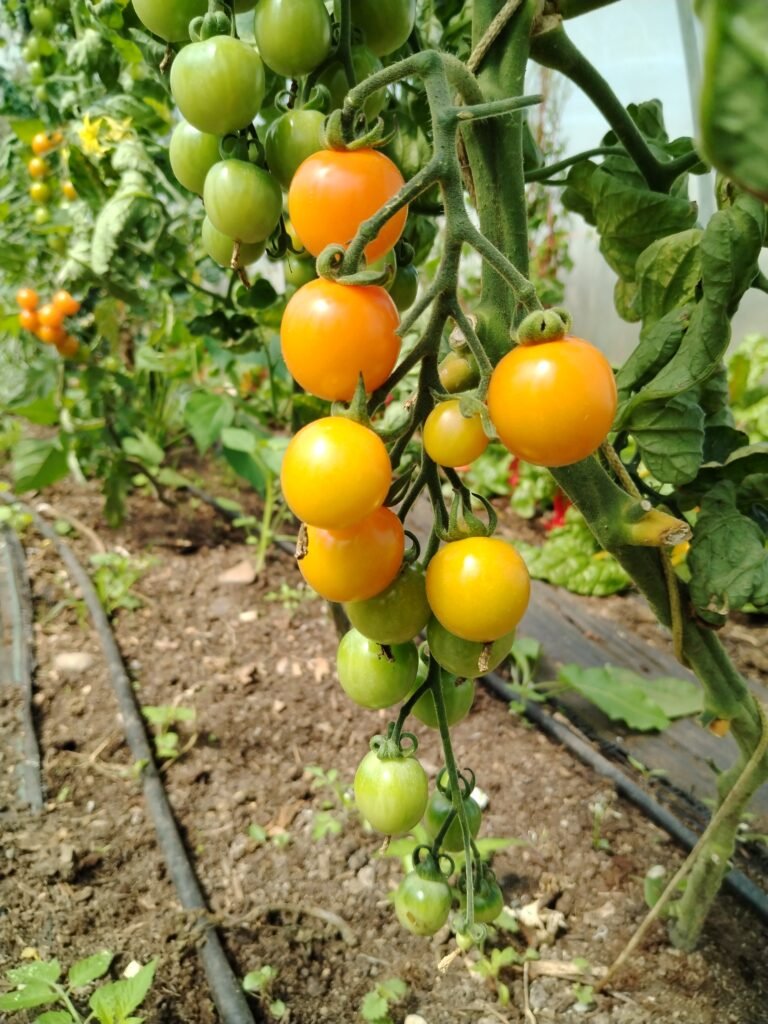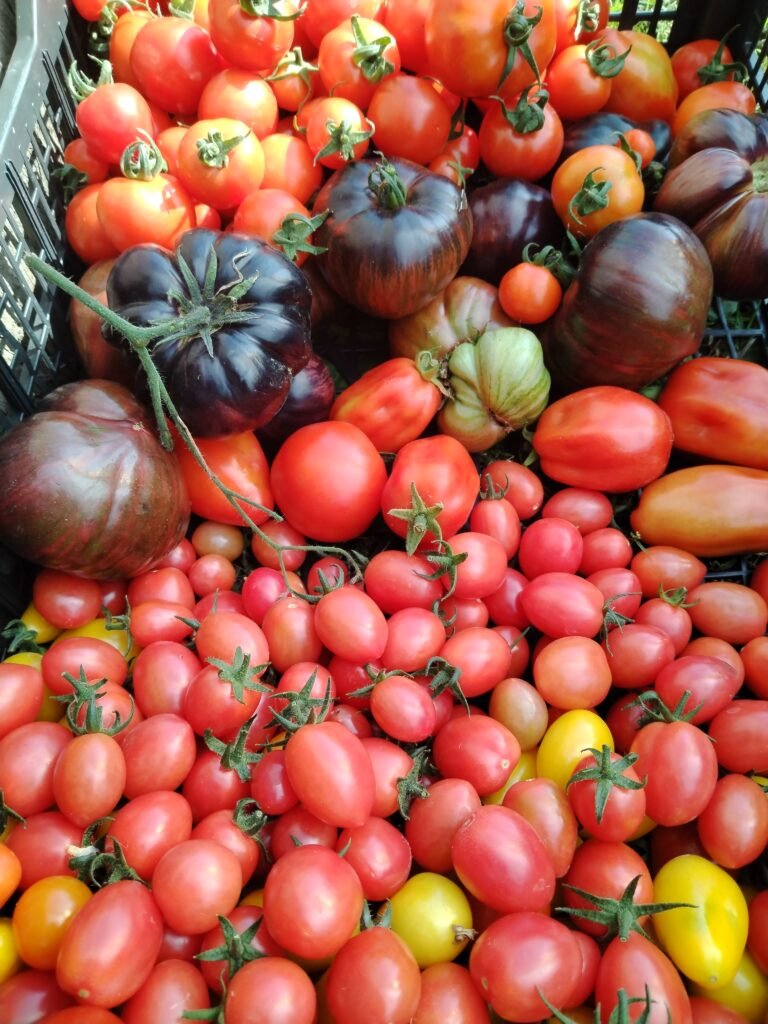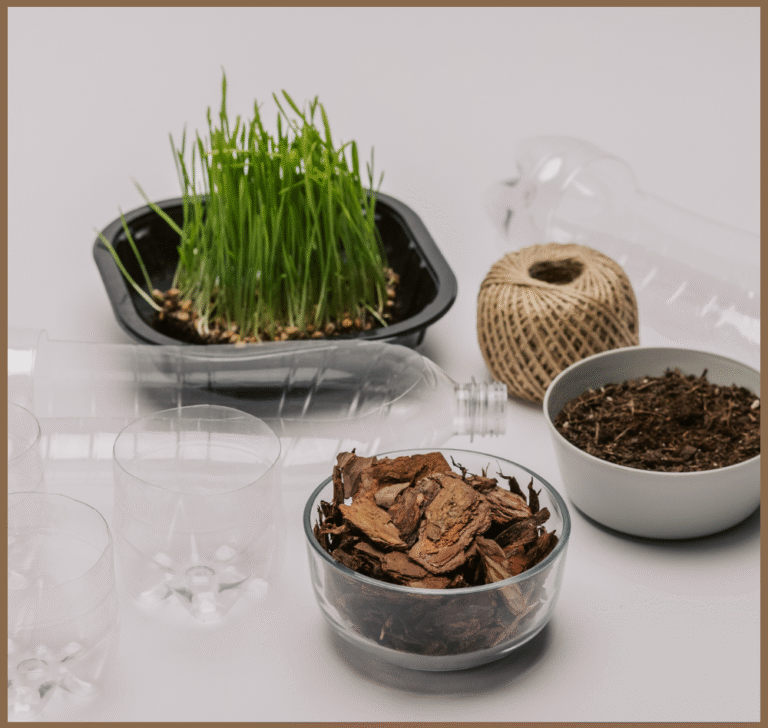


Organic tomato gardening is a true test of patience, hope, and blind devotion. There’s an old proverb that says, “A watched pot never boils,” but I’d argue a watched tomato plant grows even slower—especially under a grey Irish sky.
Every spring, we begin the ritual. Seeds are tucked into trays like tiny promises, warmed on windowsills and whispered to like old friends. But if you ask Gar why we go through all this trouble, he’ll shrug and say, “Because they taste like sweets.” And he’s not wrong. When grown right, a sun-ripened cherry tomato does taste like nature’s version of a fruit pastille—only juicier and less likely to stick in your teeth.
Meanwhile, I fall for the romance of it all. Tomatoes are like edible flowers—striped, pleated, marbled, golden, green, deep purple. Growing them feels like curating a living art gallery in the garden. And while I’m swooning over the shapes and shades, Gar is simply counting down the days until he can eat them straight off the vine like a greedy bird in a berry bush.
Of course, we can’t forget the constant chorus from friends and neighbors: “Any tomatoes yet?” As if asking will make them ripen faster. By the time the harvest finally arrives, most have moved on to courgettes—or worse, Spain.
Still, despite the chaos and the waiting, we do it again. Because when that first tomato pops—warm from the sun, full of your effort and soil’s secret magic—it’s enough to start the whole delicious madness all over again.
Why Grow Organic Tomatoes?
Let’s be honest—growing tomatoes organically isn’t just a gardening choice; it’s a gentle way of saying, “I care.” And while it does take a little more patience (especially here in Ireland, where summer sometimes shows up like a surprise guest long after the party’s started), the rewards? Oh, they’re sweet, sun-kissed, and entirely worth the wait.
First off, let’s talk about the big one: health. When you grow your own, you’re not just planting seeds—you’re planting trust. No synthetic sprays. No mystery residues. Just compost, sunlight, and that ridiculously hopeful feeling you get when the first green fruit appears. Studies even show that homegrown tomatoes, raised slowly and lovingly, contain more nutrients—especially antioxidants like lycopene—than the supermarket kind that’ve been trucked halfway across the continent before landing in your trolley. (And don’t get me started on the texture of those poor, pale cousins.)
But that’s just the beginning. Growing your own tomatoes means skipping the carbon-heavy journey of refrigerated lorries and plastic packaging. No need for jet fuel or barcode scanners when your dinner is ripening just outside the kitchen window. Every time you pick a tomato from your own vine, you’re also picking a gentler footprint for the planet. And that’s no small thing.
Of course, there’s the flavour. Once you’ve bitten into a warm, just-picked tomato, rich with sunshine and soil, you’ll understand why Gar calls them “nature’s sweets.” And truly, who could argue with that?
So yes, it’s slower. And sometimes frustrating. But growing organic tomatoes is a love letter—to your body, to the earth, and to the taste buds that deserve better.
Choosing the Right Organic Tomato Varieties
Because Every Tomato Has a Personality
Picking which tomatoes to grow is a bit like being handed a novel with 100 different endings—all of them juicy, all of them tempting. It’s easy to get swept away in the possibilities, but with a little clarity and a dash of curiosity, you can choose varieties that suit your space, tastebuds, and growing style like a glove.
Determinate vs. Indeterminate: The Great Tomato Personality Test
Before you get starry-eyed over names like ‘Purple Cherokee’ or ‘Gardeners Delight,’ let’s start with the basics. Tomatoes come in two main growth habits: determinate and indeterminate.
Determinate tomatoes are the neat-and-tidy types. They grow to a certain height, set their fruit in one impressive flush, and then bow out gracefully. Ideal for pots, raised beds, or anyone who likes a big harvest all at once—think preserving, saucing, or simply showing off.
Indeterminate tomatoes, meanwhile, are the free-spirited wanderers. These keep growing, flowering, and fruiting until the frost taps them on the shoulder. If you love a slow, steady harvest all season long (and have a sturdy trellis or two), these are your kindred spirits.
Heirloom Romance vs. Hybrid Reliability
Now for the heart of the tomato drama: heirloom or hybrid?
Heirlooms are the poets of the garden—flavourful, quirky, and rich with history. Each one tells a story, whether it’s the smoky depth of ‘Black Krim’ or the sun-warmed sweetness of ‘Brandywine.’ They’re perfect for gardeners who value taste above all and don’t mind a few imperfections along the way.
Hybrids, on the other hand, are like loyal companions. They’re bred for consistency, vigor, and resistance to common woes like blight and mildew. Especially useful if you’re gardening in a blustery Irish summer or just want to hedge your bets a bit. Look for organic-certified hybrids from trusted seed suppliers that balance disease resistance with decent flavour.
Grow What You Love to Eat
One of the easiest ways to narrow down your tomato dream list is to think about how you’ll use them.
- Slicers (like ‘Marmande’ or ‘Big Rainbow’) are brilliant for sandwiches and caprese salads.
- Paste tomatoes (like ‘Roma’ or ‘San Marzano’) are meaty and low in moisture—ideal for sauces and slow cooking.
- Cherry or grape types (‘Sungold’, ‘Sweet Aperitif’, ‘Black Cherry’) are the garden snacking heroes, often eaten straight off the vine with muddy fingers and a grin.
You can mix and match depending on your plans—grow a few of each and enjoy the full spectrum of tomato joy.
Seed Sources Matter
Finally, don’t just grab any packet off the shelf. Seek out organic, open-pollinated seed suppliers who care about biodiversity, soil health, and local adaptation. Many smaller seed companies specialise in heirloom varieties that thrive in cooler climates—ideal for our temperate, rain-kissed Irish plots.
Bonus tip: save the seed from your favourite heirlooms at the end of the season and start your own tomato legacy. It’s easier than you think—and just might become your new favourite garden ritual.
The beauty of choosing tomato varieties is that there’s no wrong answer—only delicious ones. Let your curiosity lead, your recipes inspire, and your garden surprise you.
Preparing the Perfect Organic Soil
Before we so much as whisper sweet nothings to a seedling, we need to talk about the real hero of any thriving tomato patch: the soil. Yes, the humble, underfoot, often-overlooked earth. In organic gardening, it’s not just dirt—it’s dinner, home, and health all rolled into one.
It’s Alive! (And That’s a Good Thing)
Let’s begin with a truth: good soil is alive. Under the surface, there’s an entire bustling community of microbes, earthworms, fungi, and good bacteria all working behind the scenes. It’s basically the original farm-to-table team effort. These soil-dwelling helpers break down organic matter and feed your plants like tiny chefs preparing a gourmet feast. When you nurture your soil, you’re really nurturing next month’s salad.
Compost: Your Garden’s Best Friend
So where do we start? With compost, of course. And not the sad, half-decomposed stuff—we’re talking rich, dark, crumbly, smells-like-the-forest kind of compost. If you make your own, fantastic. If not, a quality garden compost or organic mushroom compost can work wonders. Mix a generous layer—around 6 inches—into the topsoil before planting. Add in some well-aged manure or even worm castings (hello, local worm farmer!) if your plants need a little extra pep in their step.
Affiliate tip: We’ve had great results using Get the pH Just Right
Now, tomatoes are fussy eaters—they like their soil slightly acidic, between 6.0 and 6.8. If you’ve never tested your soil before, it’s easier than you think. Grab a simple home soil pH kit or a digital meter and see where you stand. If it’s too acidic, sprinkle in a little garden lime. If it’s leaning alkaline, elemental sulfur will bring it back into balance. Just be gentle—this isn’t a tug-of-war, it’s more of a polite nudge.
The No-Dig Method: Because the Earth Deserves a Rest Too
If digging sounds like a chore, you’re in luck—because the no-dig method is not only easier on your back, it’s better for your soil. Instead of turning the earth over like a stew, you layer organic materials on top and let nature take the lead. Start with a layer of cardboard or newspaper to smother weeds, then top it off with leaf mold, compost, and straw. Over time, this rich mulch breaks down into a luscious, living growing medium that your tomatoes will love.
And bonus? You’re protecting delicate soil structures and encouraging beneficial microbes to thrive, all while sipping your tea and admiring your handiwork.
Planting and Supporting Organic Tomato Plants
Ah, planting day. There’s a certain hush about it, don’t you think? That magical pause where hope meets soil, and every seedling is a little green promise. After all the compost-mixing, pot-fussing, and weather-watching, it’s finally time to introduce your tomatoes to their forever home.
Timing Is Everything (Especially in Ireland)
Let’s start with a little tough love: don’t be hasty. Tomatoes are heat-seekers, and if you plop them in too early, they’ll sit there in a sulk, refusing to grow. Wait until the threat of frost is gone and your soil is cozy—aim for at least 10°C (50°F). A soil thermometer makes this easy and helps you avoid guesswork.
If your seedlings have been pampered indoors like little divas (as they should be), it’s only fair to ease them into the big wide world. Set them outside for a few hours each day over a week—this hardening off process helps them toughen up without throwing a fit.
Plant Deep, Dream Big
When it comes to planting, go deep—deeper than you think. Strip the bottom leaves and bury the stem up to the top few sets of leaves. Why? Because tomatoes are sneaky root-growers, and planting them deep lets them develop strong, sprawling root systems. It’s like giving them an underground mansion.
Affiliate tip: A long-handled dibber or garden trowel with depth markers makes deep planting a breeze (and saves your wrists too).
Give each plant at least 60 cm (2 feet) of breathing room, choose a sun-drenched spot, and keep the air flowing between them—tomatoes don’t like to be crowded or damp, and airflow keeps blight at bay.
Give Them a Lift (Literally)
Once your tomatoes are tucked in, they’ll start growing like teenagers—fast, unruly, and in all directions. Get ahead of the chaos by adding supports early. Whether you fancy cages, bamboo stakes, or a rustic stake-and-string system, the key is to get those fruits off the ground and keep stems supported as they stretch skyward. Tie gently with twine and check often—they grow quicker than a rumour in a small village.
Invite the Right Company
Tomatoes, like us, thrive with good neighbours. Basil isn’t just for pairing on the plate—it actually improves tomato flavour and fends off pests. Marigolds ward off nematodes (and look cheerful doing it), and nasturtiums act as both pollinator magnets and pest decoys.
On the other hand, avoid the bad apples—potatoes and fennel are known to be less-than-friendly, competing for nutrients and creating awkward tension underground.
A Gentle Start: Natural Root Boosters
Worried about transplant shock? Skip the synthetic feeds and opt for something a bit more… nurturing. A splash of diluted liquid seaweed feed or a lukewarm cup of chamomile tea at planting time gives your seedlings a calming start. Both are rich in natural compounds that reduce stress and promote healthy roots. And they smell lovely too.
Planting tomatoes isn’t just about digging holes—it’s a quiet act of hope, a ritual of care. If you plant with patience, support with love, and invite the right companions, your tomatoes will return the favour with flavour that supermarket shelves can only dream of.
Natural Pest and Disease Control for Tomatoes
When Aphids Attack and Slugs Throw Shade
Growing organic tomatoes can feel a bit like parenting passionate, temperamental teens. One minute they’re basking in the sun, bursting with promise—and the next, they’re in full meltdown mode over a slug or an unexpected patch of mildew. But don’t worry—we’re going to keep things calm, collected, and chemical-free.
Know Your Foes Before They Munch
Before you go reaching for the bug spray (don’t), get to know the usual suspects. Aphids are the clingy types, whiteflies are floaty little nuisances, and spider mites cause more trouble than their size would suggest. While the tomato hornworm is more of a legend in warmer climates, slugs here in Ireland are all too real and all too hungry—especially for tender seedlings.
But here’s the good news: you’ve got a whole arsenal of gentle remedies that work with nature, not against it.
Homegrown Solutions That Actually Work
First up, sprays. Whip up a homemade garlic and chilli solution, or keep a bottle of organic neem oil handy for a natural pest repellent. A spritz every few days on affected leaves usually does the trick, and it smells a bit like you’ve invited your tomatoes to dinner.
To deter slugs and snails, try sprinkling crushed eggshells, coffee grounds, or even a fine layer of diatomaceous earth around the base of your plants. Not only does it create a gritty barrier, but it adds minerals to the soil, too—everyone wins (except the slugs).
Companion Planting: Nature’s Secret Weapon
If you haven’t fallen in love with companion planting yet, now’s the time. Marigolds are absolute queens—charming to look at, brilliant at deterring whiteflies and nematodes. Basil does double duty, making your tomatoes taste better and baffling winged intruders. Calendula, nasturtium, and borage are more than pretty faces—they bring in ladybirds, hoverflies, and bees, who happily snack on aphids and pollinate as they go.
And if you want to throw in something aromatic and protective, try garlic or chives. They’re like bodyguards with culinary perks.
Build a Backyard Biodiversity Club
Organic pest control isn’t just about keeping pests away—it’s about making your garden so vibrant and diverse that nature takes care of the balance for you. Plant a patch of wildflowers, install a simple insect hotel, or leave a shallow bowl of water with pebbles for your pollinator friends to perch on and sip from. Every little addition turns your garden into a living, breathing ecosystem.
Stay Alert, Stay Ahead
Now, we can’t talk tomatoes without mentioning blight—that sneaky fungal villain that thrives in damp, still air. The moment you notice brown spots or mushy stems, don’t wait. Prune off affected leaves, clean your tools, and dispose of any infected plant parts away from your compost.
A weekly mist of diluted milk spray or a homemade compost tea can give your tomatoes a probiotic-style immune boost. And as always, healthy plants start from the soil up—so if your ground is rich and your roots are happy, your tomatoes are already halfway to resilience.
With a watchful eye, a few herbal allies, and some clever companion planting, you’ll have a garden that practically defends itself. Because when nature’s in balance, even the drama queens of the vegetable patch find their peace.
Watering, Feeding & Maintenance the Organic Way
Because Thriving Tomatoes Deserve a Little Daily Devotion
Once your tomato plants are tucked into the soil, stretching towards the sun like sleepy cats, the real magic begins. This phase is all about care—the kind that happens in quiet morning moments with a watering can in hand or an evening spent chatting to your plants while you tie up their stems.
Water: A Deep Drink, Not a Shallow Sip
Tomatoes, like most of us, prefer a deep meaningful connection over small talk. That means watering deeply but not too often. Aim for around 1 to 1.5 inches (3–4 cm) of water a week—more during dry spells. Use a watering wand or soaker hose to deliver moisture right to the roots, and do it early in the day if you can. This keeps the foliage dry, which helps fend off fungal problems like blight or mildew.
If your soil is mulched (and it should be!), you’ll also hold moisture better—think straw, grass clippings, or even shredded leaves for that earthy, lived-in garden look.
Feed: Slow, Steady, and Soil-Friendly
Feeding your tomatoes isn’t about quick fixes—it’s about slow nutrition that builds flavour and resilience. Organic options like well-rotted compost, worm castings, and homemade comfrey tea offer steady nourishment without overwhelming your plants.
Start feeding once the first flowers appear, and continue every 1–2 weeks during fruiting. Seaweed extract is another wonderful tonic, especially for potassium-hungry fruiting plants. Just remember: always water before you feed. It helps the nutrients soak in rather than shock the roots.
Tip: Keep a little bucket or bottle of diluted comfrey tea on hand. It smells like swamp soup but works like magic.
Prune: Gently Guide, Don’t Dominate
A little light pruning can go a long way. Remove any yellowing lower leaves and pinch off the suckers—those enthusiastic little shoots that grow between leaf and stem. This helps improve airflow, keeps disease at bay, and encourages your plant to focus on fruit, not just foliage.
Use clean, sharp pruners or just your fingers, and take a moment to admire how sculptural your plant is becoming. It’s a bit like bonsai for the impatient gardener.
Maintain: Your Weekly Tomato Ritual
Think of tomato care as a simple rhythm rather than a chore. A weekly walk-through is all it takes:
- Check for pests or signs of disease
- Remove any yellowing or spotty leaves
- Gently tie up new growth
- Top up your mulch layer
- Whisper a kind word or two (optional, but recommended)
These quiet check-ins become second nature, and they build a bond between you and your plants that’s hard to explain—but deeply satisfying.
In the end, organic tomato care is less about perfection and more about presence. You’re not just growing fruit—you’re nurturing a relationship with your garden, your soil, and the season itself.
Harvesting and Saving Seeds
The Sweetest Ending—and the Most Hopeful Beginning
There’s a special kind of magic in that first bite of a sun-ripened tomato. Warm from the vine, bursting with flavour, and full of everything your garden has given. But before you start gathering them by the basketful, let’s take a moment to harvest mindfully—and preserve a little piece of this season for the next.
When to Pick: Look, Squeeze, Sniff
A ripe tomato will let you know when it’s ready. Look for full colour—whether that’s rich red, golden yellow, or dusky black, depending on the variety. Give it a gentle squeeze; it should yield just slightly under your fingers. And if it smells like a tomato—that earthy-sweet, sun-soaked aroma—it’s go time.
Still unsure? If in doubt, it’s better to harvest a little early. Tomatoes will happily finish ripening indoors on a sunny windowsill.
Tip: Harvest in the cool of the morning. The fruits will be firmer, the plant less stressed, and you’ll avoid wilting in the midday heat.
How to Harvest: Be Kind to the Vine
Resist the urge to tug. Instead, give the fruit a gentle twist, or use a clean pair of garden scissors or pruners to snip it free. This reduces damage to the plant—and lowers the risk of disease entering through broken stems.
And don’t forget to check under the foliage. Sometimes the best tomatoes hide in plain sight, tucked beneath a leaf like treasure.
Saving Seeds: A Gift to Your Future Self
Seed-saving is where the garden becomes truly cyclical—and personal. Choose a few of your best, tastiest tomatoes from open-pollinated (non-hybrid) varieties. These are your legacy tomatoes.
Here’s how to do it:
- Scoop the seeds into a small jar with a little water.
- Let the mixture ferment for 3–5 days, stirring daily. It’ll smell a bit funky—that’s okay! This breaks down the natural germination inhibitor.
- Rinse the seeds through a fine sieve, then dry thoroughly on a paper towel or coffee filter.
- Label carefully with variety and date (you think you’ll remember, but trust us—you won’t).
Once dry, tuck your seeds into an envelope and store them somewhere cool, dark, and dry. A repurposed tea tin or seed-saving box works beautifully. Next year’s garden, ready and waiting.
Tomatoes may be seasonal, but seed-saving stretches the story. One fruit becomes dozens of future plants. And with a little care, your favourite tomato can live on—flavourfully and organically—for years to come.
A Final Word on Growing Organic Tomatoes
So there you have it—the tomato journey from seed to sauce, from tiny green starts to juicy, sun-blushed gems. It’s a tale of patience, pests, pruning, and a touch of plant-parent intuition. Growing organic tomatoes isn’t always the easiest path, but oh, is it ever the most rewarding. Each fruit tells a story—of careful choices, composted dreams, and those little everyday rituals that bring life to your garden.
And while you’ve now got all the basics down—from choosing the right variety to feeding and harvesting with care—remember, there’s always room to play. Whether you’re craving sandwich-ready slicers or tiny flavour bombs to eat straight from the vine, tomatoes are a wonderfully diverse bunch.
If you’re feeling adventurous, why not explore beyond the classics? There’s a whole world of colourful, quirky, and downright magical tomato varieties out there—each with their own personality and growing quirks. Take a peek at our post on unusual tomato varieties here and let your curiosity run wild.
In the end, tomatoes remind us of the joy in the process. The daily tending, the small surprises, the sun on your back as you check for ripe ones—it’s about more than just food. It’s nourishment for the soul, too.
So plant with intention, water with love, and don’t forget to stop and admire your work. Because in every organic tomato, there’s a little bit of you.





